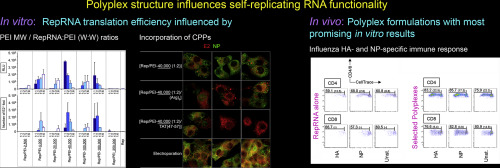Journal of Controlled Release ( IF 10.8 ) Pub Date : 2017-09-19 , DOI: 10.1016/j.jconrel.2017.09.018 Thomas Démoulins , Thomas Ebensen , Kai Schulze , Pavlos C. Englezou , Maria Pelliccia , Carlos A. Guzmán , Nicolas Ruggli , Kenneth C. McCullough

|
The major limitations with large and complex self-amplifying RNA vaccines (RepRNA) are RNase-sensitivity and inefficient translation in dendritic cells (DCs). Condensing RepRNA with polyethylenimine (PEI) gave positive in vitro readouts, but was largely inferior to virus-like replicon particles (VRP) or direct electroporation. In the present study, we improved such polyplex formulation and determined that fine-tuning of the polyplex structure is essential for ensuring efficacious translation. Thereby, three parameters dominate: (i) PEI molecular weight (MW); (ii) RepRNA:PEI (weight:weight) ratio; and (iii) inclusion of cell penetrating peptides (CPPs). Seven commercially available linear PEIs (MW 2,500–250,000) were classified as strong, intermediate or low for their aptitude at complexing and protecting RepRNA for delivery into porcine blood DCs. Inclusion of (Arg)9 or TAT(57-57) CPPs further modified the translation readouts, but varied for different gene expressions. Dependent on the formulation, translation of the gene of interest (GOI) inserted into the RepRNA (luciferase, or influenza virus hemagglutinin or nucleoprotein) could decrease, while the RepRNA structural gene (E2) translation increased. This was noted in the porcine SK6 cell line, as well as both porcine and, for the first time, human DCs. Two formulations – [Rep/PEI-4,000 (1:3)] and [Rep/PEI-40,000 (1:2)/(Arg)9] were efficacious in vivo in mice and pigs, where specific CD8+ T and CD4+ T-cell responses against the GOI-encoded antigen were observed for the first time. The results demonstrate that different polyplex formulations differ in their interaction with the RepRNA such that only certain genes can be translated. Thus, delivery of these large self-replicating RNA molecules require definition with respect to translation of different genes, rather than just the GOI as is the norm, for identifying optimal delivery for the desired immune activation in vivo.
中文翻译:

微复传递载体结构的微调调节自我复制RNA疫苗的功能。
大型且复杂的自扩增RNA疫苗(RepRNA)的主要局限性在于RNase敏感性和在树突状细胞(DC)中的翻译效率低下。用聚乙烯亚胺(PEI)浓缩RepRNA可以得到良好的体外读数,但远不及病毒样复制子颗粒(VRP)或直接电穿孔。在本研究中,我们改进了这种多链体的配方,并确定了对多链体结构的微调对于确保有效翻译至关重要。因此,三个参数占主导地位:(i)PEI分子量(MW);(ii)RepRNA:PEI(重量:重量)比;(iii)包含细胞穿透肽(CPP)。七种市售线性PEI(MW 2500至250,000)因其在复杂和保护RepRNA进入猪血DC中的适应能力而被分为强,中或低三类。包含(Arg)9或TAT(57-57)CPP进一步修饰了翻译读数,但因不同的基因表达而异。取决于配方,插入RepRNA(荧光素酶或流感病毒血凝素或核蛋白)的目的基因(GOI)的翻译可能会减少,而RepRNA结构基因(E2)的翻译会增加。这在猪SK6细胞系以及猪DC和人类DC中都已注意到。两种制剂– [Rep / PEI- 4,000(1:3)]和[Rep / PEI- 40,000(1:2)/(Arg)9 ]在体内有效在小鼠和猪中,首次观察到针对GOI编码抗原的特异性CD8 + T和CD4 + T细胞反应。结果表明,不同的多链体制剂与RepRNA的相互作用不同,因此仅某些基因可以被翻译。因此,这些大的自我复制RNA分子的递送需要针对不同基因的翻译进行定义,而不仅仅是正常情况下的GOI,以便鉴定体内期望的免疫激活的最佳递送。



























 京公网安备 11010802027423号
京公网安备 11010802027423号